Yujie Wei
Taming Consistency Distillation for Accelerated Human Image Animation
Apr 15, 2025Abstract:Recent advancements in human image animation have been propelled by video diffusion models, yet their reliance on numerous iterative denoising steps results in high inference costs and slow speeds. An intuitive solution involves adopting consistency models, which serve as an effective acceleration paradigm through consistency distillation. However, simply employing this strategy in human image animation often leads to quality decline, including visual blurring, motion degradation, and facial distortion, particularly in dynamic regions. In this paper, we propose the DanceLCM approach complemented by several enhancements to improve visual quality and motion continuity at low-step regime: (1) segmented consistency distillation with an auxiliary light-weight head to incorporate supervision from real video latents, mitigating cumulative errors resulting from single full-trajectory generation; (2) a motion-focused loss to centre on motion regions, and explicit injection of facial fidelity features to improve face authenticity. Extensive qualitative and quantitative experiments demonstrate that DanceLCM achieves results comparable to state-of-the-art video diffusion models with a mere 2-4 inference steps, significantly reducing the inference burden without compromising video quality. The code and models will be made publicly available.
DreamRelation: Relation-Centric Video Customization
Mar 10, 2025Abstract:Relational video customization refers to the creation of personalized videos that depict user-specified relations between two subjects, a crucial task for comprehending real-world visual content. While existing methods can personalize subject appearances and motions, they still struggle with complex relational video customization, where precise relational modeling and high generalization across subject categories are essential. The primary challenge arises from the intricate spatial arrangements, layout variations, and nuanced temporal dynamics inherent in relations; consequently, current models tend to overemphasize irrelevant visual details rather than capturing meaningful interactions. To address these challenges, we propose DreamRelation, a novel approach that personalizes relations through a small set of exemplar videos, leveraging two key components: Relational Decoupling Learning and Relational Dynamics Enhancement. First, in Relational Decoupling Learning, we disentangle relations from subject appearances using relation LoRA triplet and hybrid mask training strategy, ensuring better generalization across diverse relationships. Furthermore, we determine the optimal design of relation LoRA triplet by analyzing the distinct roles of the query, key, and value features within MM-DiT's attention mechanism, making DreamRelation the first relational video generation framework with explainable components. Second, in Relational Dynamics Enhancement, we introduce space-time relational contrastive loss, which prioritizes relational dynamics while minimizing the reliance on detailed subject appearances. Extensive experiments demonstrate that DreamRelation outperforms state-of-the-art methods in relational video customization. Code and models will be made publicly available.
FreeScale: Unleashing the Resolution of Diffusion Models via Tuning-Free Scale Fusion
Dec 12, 2024



Abstract:Visual diffusion models achieve remarkable progress, yet they are typically trained at limited resolutions due to the lack of high-resolution data and constrained computation resources, hampering their ability to generate high-fidelity images or videos at higher resolutions. Recent efforts have explored tuning-free strategies to exhibit the untapped potential higher-resolution visual generation of pre-trained models. However, these methods are still prone to producing low-quality visual content with repetitive patterns. The key obstacle lies in the inevitable increase in high-frequency information when the model generates visual content exceeding its training resolution, leading to undesirable repetitive patterns deriving from the accumulated errors. To tackle this challenge, we propose FreeScale, a tuning-free inference paradigm to enable higher-resolution visual generation via scale fusion. Specifically, FreeScale processes information from different receptive scales and then fuses it by extracting desired frequency components. Extensive experiments validate the superiority of our paradigm in extending the capabilities of higher-resolution visual generation for both image and video models. Notably, compared with the previous best-performing method, FreeScale unlocks the generation of 8k-resolution images for the first time.
Timestep Embedding Tells: It's Time to Cache for Video Diffusion Model
Nov 28, 2024


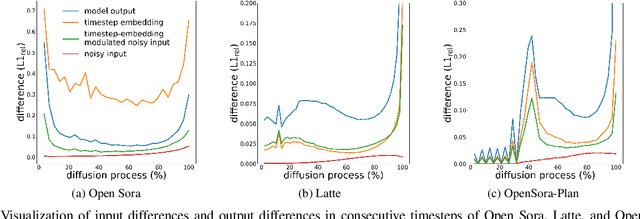
Abstract:As a fundamental backbone for video generation, diffusion models are challenged by low inference speed due to the sequential nature of denoising. Previous methods speed up the models by caching and reusing model outputs at uniformly selected timesteps. However, such a strategy neglects the fact that differences among model outputs are not uniform across timesteps, which hinders selecting the appropriate model outputs to cache, leading to a poor balance between inference efficiency and visual quality. In this study, we introduce Timestep Embedding Aware Cache (TeaCache), a training-free caching approach that estimates and leverages the fluctuating differences among model outputs across timesteps. Rather than directly using the time-consuming model outputs, TeaCache focuses on model inputs, which have a strong correlation with the modeloutputs while incurring negligible computational cost. TeaCache first modulates the noisy inputs using the timestep embeddings to ensure their differences better approximating those of model outputs. TeaCache then introduces a rescaling strategy to refine the estimated differences and utilizes them to indicate output caching. Experiments show that TeaCache achieves up to 4.41x acceleration over Open-Sora-Plan with negligible (-0.07% Vbench score) degradation of visual quality.
PersonalVideo: High ID-Fidelity Video Customization without Dynamic and Semantic Degradation
Nov 26, 2024
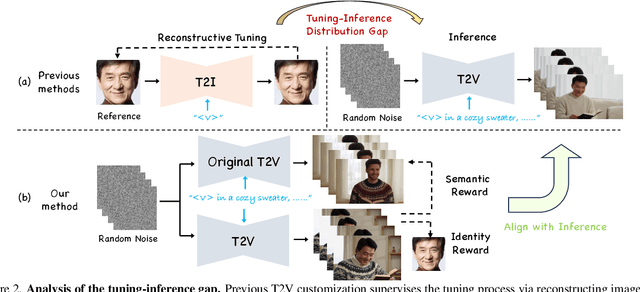
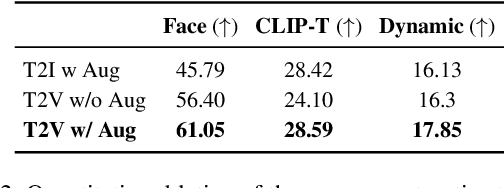
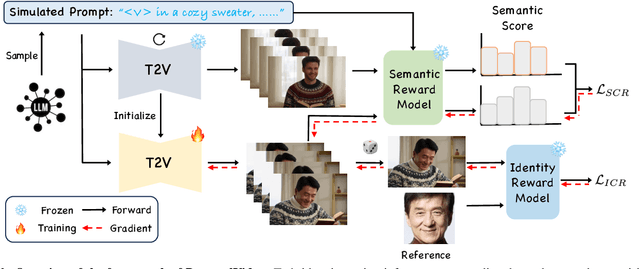
Abstract:The current text-to-video (T2V) generation has made significant progress in synthesizing realistic general videos, but it is still under-explored in identity-specific human video generation with customized ID images. The key challenge lies in maintaining high ID fidelity consistently while preserving the original motion dynamic and semantic following after the identity injection. Current video identity customization methods mainly rely on reconstructing given identity images on text-to-image models, which have a divergent distribution with the T2V model. This process introduces a tuning-inference gap, leading to dynamic and semantic degradation. To tackle this problem, we propose a novel framework, dubbed \textbf{PersonalVideo}, that applies direct supervision on videos synthesized by the T2V model to bridge the gap. Specifically, we introduce a learnable Isolated Identity Adapter to customize the specific identity non-intrusively, which does not comprise the original T2V model's abilities (e.g., motion dynamic and semantic following). With the non-reconstructive identity loss, we further employ simulated prompt augmentation to reduce overfitting by supervising generated results in more semantic scenarios, gaining good robustness even with only a single reference image available. Extensive experiments demonstrate our method's superiority in delivering high identity faithfulness while preserving the inherent video generation qualities of the original T2V model, outshining prior approaches. Notably, our PersonalVideo seamlessly integrates with pre-trained SD components, such as ControlNet and style LoRA, requiring no extra tuning overhead.
DreamVideo-2: Zero-Shot Subject-Driven Video Customization with Precise Motion Control
Oct 17, 2024
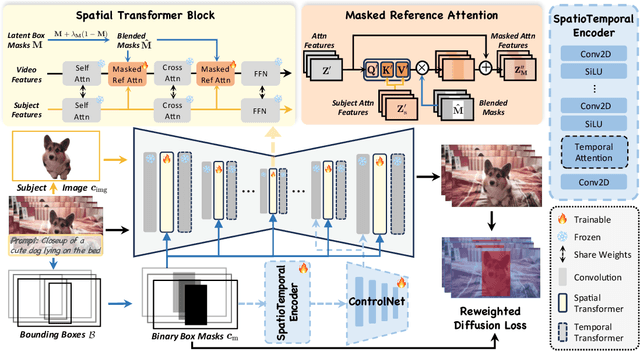

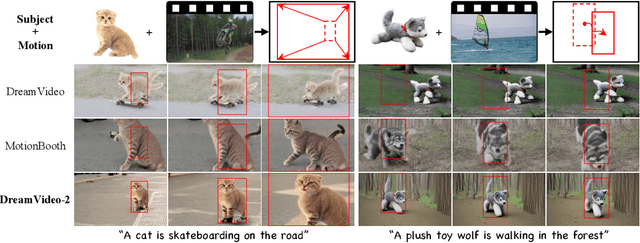
Abstract:Recent advances in customized video generation have enabled users to create videos tailored to both specific subjects and motion trajectories. However, existing methods often require complicated test-time fine-tuning and struggle with balancing subject learning and motion control, limiting their real-world applications. In this paper, we present DreamVideo-2, a zero-shot video customization framework capable of generating videos with a specific subject and motion trajectory, guided by a single image and a bounding box sequence, respectively, and without the need for test-time fine-tuning. Specifically, we introduce reference attention, which leverages the model's inherent capabilities for subject learning, and devise a mask-guided motion module to achieve precise motion control by fully utilizing the robust motion signal of box masks derived from bounding boxes. While these two components achieve their intended functions, we empirically observe that motion control tends to dominate over subject learning. To address this, we propose two key designs: 1) the masked reference attention, which integrates a blended latent mask modeling scheme into reference attention to enhance subject representations at the desired positions, and 2) a reweighted diffusion loss, which differentiates the contributions of regions inside and outside the bounding boxes to ensure a balance between subject and motion control. Extensive experimental results on a newly curated dataset demonstrate that DreamVideo-2 outperforms state-of-the-art methods in both subject customization and motion control. The dataset, code, and models will be made publicly available.
EvolveDirector: Approaching Advanced Text-to-Image Generation with Large Vision-Language Models
Oct 10, 2024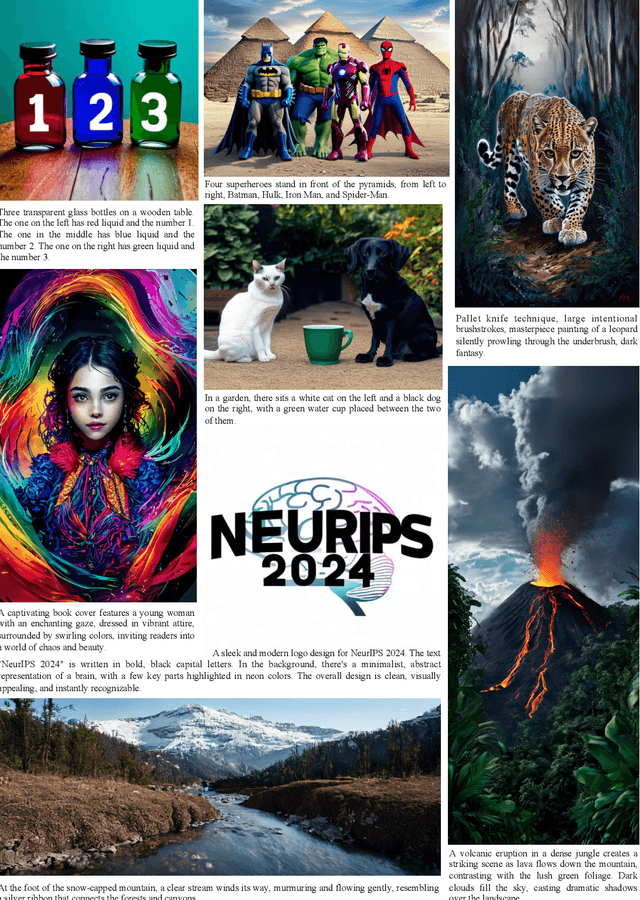
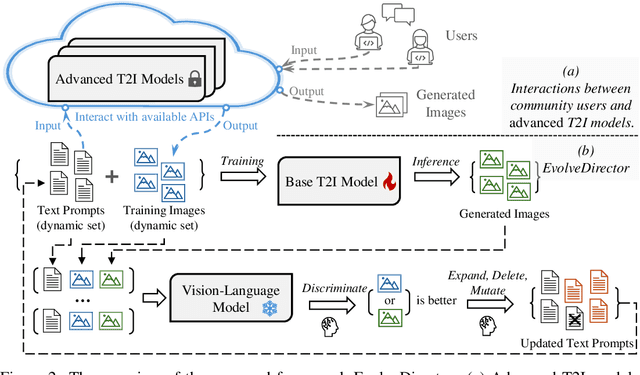
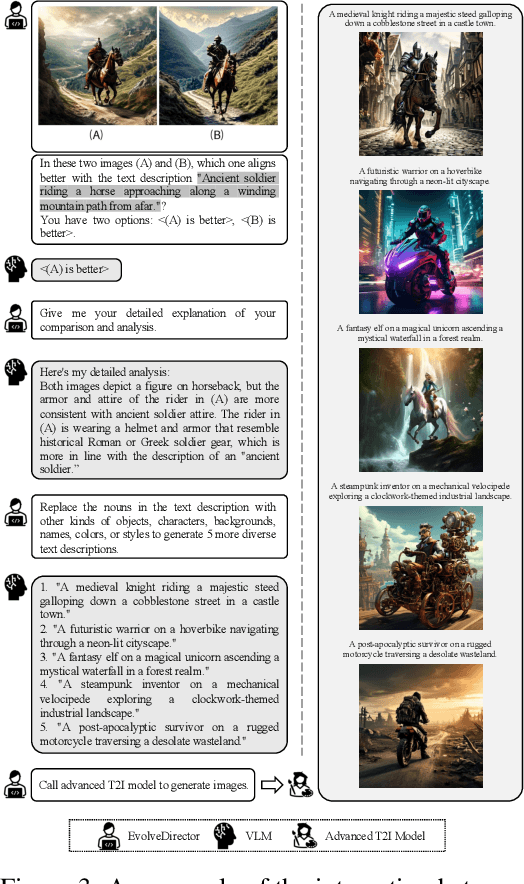
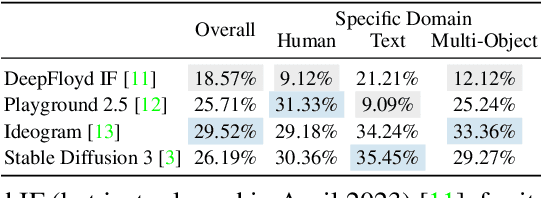
Abstract:Recent advancements in generation models have showcased remarkable capabilities in generating fantastic content. However, most of them are trained on proprietary high-quality data, and some models withhold their parameters and only provide accessible application programming interfaces (APIs), limiting their benefits for downstream tasks. To explore the feasibility of training a text-to-image generation model comparable to advanced models using publicly available resources, we introduce EvolveDirector. This framework interacts with advanced models through their public APIs to obtain text-image data pairs to train a base model. Our experiments with extensive data indicate that the model trained on generated data of the advanced model can approximate its generation capability. However, it requires large-scale samples of 10 million or more. This incurs significant expenses in time, computational resources, and especially the costs associated with calling fee-based APIs. To address this problem, we leverage pre-trained large vision-language models (VLMs) to guide the evolution of the base model. VLM continuously evaluates the base model during training and dynamically updates and refines the training dataset by the discrimination, expansion, deletion, and mutation operations. Experimental results show that this paradigm significantly reduces the required data volume. Furthermore, when approaching multiple advanced models, EvolveDirector can select the best samples generated by them to learn powerful and balanced abilities. The final trained model Edgen is demonstrated to outperform these advanced models. The code and model weights are available at https://github.com/showlab/EvolveDirector.
AP-LDM: Attentive and Progressive Latent Diffusion Model for Training-Free High-Resolution Image Generation
Oct 08, 2024


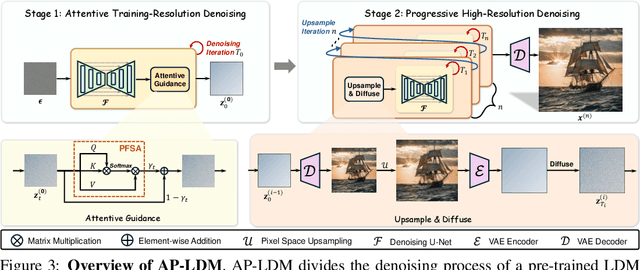
Abstract:Latent diffusion models (LDMs), such as Stable Diffusion, often experience significant structural distortions when directly generating high-resolution (HR) images that exceed their original training resolutions. A straightforward and cost-effective solution is to adapt pre-trained LDMs for HR image generation; however, existing methods often suffer from poor image quality and long inference time. In this paper, we propose an Attentive and Progressive LDM (AP-LDM), a novel, training-free framework aimed at enhancing HR image quality while accelerating the generation process. AP-LDM decomposes the denoising process of LDMs into two stages: (i) attentive training-resolution denoising, and (ii) progressive high-resolution denoising. The first stage generates a latent representation of a higher-quality training-resolution image through the proposed attentive guidance, which utilizes a novel parameter-free self-attention mechanism to enhance the structural consistency. The second stage progressively performs upsampling in pixel space, alleviating the severe artifacts caused by latent space upsampling. Leveraging the effective initialization from the first stage enables denoising at higher resolutions with significantly fewer steps, enhancing overall efficiency. Extensive experimental results demonstrate that AP-LDM significantly outperforms state-of-the-art methods, delivering up to a 5x speedup in HR image generation, thereby highlighting its substantial advantages for real-world applications. Code is available at https://github.com/kmittle/AP-LDM.
CLIP model is an Efficient Online Lifelong Learner
May 24, 2024Abstract:Online Lifelong Learning (OLL) addresses the challenge of learning from continuous and non-stationary data streams. Existing online lifelong learning methods based on image classification models often require preset conditions such as the total number of classes or maximum memory capacity, which hinders the realization of real never-ending learning and renders them impractical for real-world scenarios. In this work, we propose that vision-language models, such as Contrastive Language-Image Pretraining (CLIP), are more suitable candidates for online lifelong learning. We discover that maintaining symmetry between image and text is crucial during Parameter-Efficient Tuning (PET) for CLIP model in online lifelong learning. To this end, we introduce the Symmetric Image-Text (SIT) tuning strategy. We conduct extensive experiments on multiple lifelong learning benchmark datasets and elucidate the effectiveness of SIT through gradient analysis. Additionally, we assess the impact of lifelong learning on generalizability of CLIP and found that tuning the image encoder is beneficial for lifelong learning, while tuning the text encoder aids in zero-shot learning.
InstructVideo: Instructing Video Diffusion Models with Human Feedback
Dec 19, 2023



Abstract:Diffusion models have emerged as the de facto paradigm for video generation. However, their reliance on web-scale data of varied quality often yields results that are visually unappealing and misaligned with the textual prompts. To tackle this problem, we propose InstructVideo to instruct text-to-video diffusion models with human feedback by reward fine-tuning. InstructVideo has two key ingredients: 1) To ameliorate the cost of reward fine-tuning induced by generating through the full DDIM sampling chain, we recast reward fine-tuning as editing. By leveraging the diffusion process to corrupt a sampled video, InstructVideo requires only partial inference of the DDIM sampling chain, reducing fine-tuning cost while improving fine-tuning efficiency. 2) To mitigate the absence of a dedicated video reward model for human preferences, we repurpose established image reward models, e.g., HPSv2. To this end, we propose Segmental Video Reward, a mechanism to provide reward signals based on segmental sparse sampling, and Temporally Attenuated Reward, a method that mitigates temporal modeling degradation during fine-tuning. Extensive experiments, both qualitative and quantitative, validate the practicality and efficacy of using image reward models in InstructVideo, significantly enhancing the visual quality of generated videos without compromising generalization capabilities. Code and models will be made publicly available.
 Add to Chrome
Add to Chrome Add to Firefox
Add to Firefox Add to Edge
Add to Edge